

Over the past two months I have been playing with HF antennas in the range of 3.5MHz to 29.7MHz. My basic problem is one of the the two radio amateurs nightmares - lack of space. I just don't have it available. I used to live in a villa outside Arlanda, and with 2200 square metres of garden I was spoilled rotten. Just for fun I put up a full, centre-fed dipole for 1.8MHz.
Today I have a little house in Märsta with a very small garden that is just 8 metres wide. In addition I have a local community that have strict regulation as to what I can erect. Basically, if it has a high-profile then I have to take it down. I need to find a limited space antenna solution that will let me use 7MHz through to 29.7MHz. 3.5MHz has been achieved, but I have an S9 level of noise on the 80m band, so that will be a project for later.
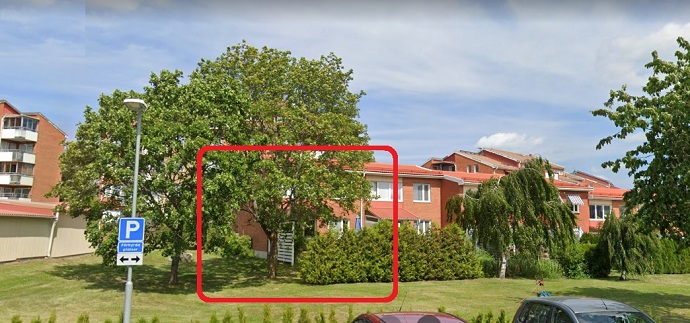
In addition to this I cannot run loads of wires beside the house as it is an end-terrace house. There is only one neighbour :-), but the other side is visible to the public and the community officials :-( I can realistically get away with just one coaxial cable.
So here are the results of my experiments and my final result that will cover all bands from 7Mhz to 29.7MHz. I can also add 3.5MHz, but I will just give you the information for that band and see if you get a better solution.

If you check my messageboard SM0VPO forum is here. you will see some of my posts and some of the really valuable and clever ideas I received. I actually did try some of the ideas and some I incorporated in the final design, others were discounted for several reasons. I do have a lovely variable length antenna yet to experiment with.
One experiment was to use computer ribbon cable. The conductors were all connected together to form one half of my dipole. The other ends were stripped back and cut to different lengths to get a resonance at the bands of interest. The last metre of each element was left hanging in an effort to stop interraction between elements. I did get a multi-band antenna working, but when running only 100 watts, the thin cable at the feed point got hot and even melted the plastic. I believe the thin conductors were dissipating more than a little RF power. It is a pity as this would have been an elegant and low-profile solution.
I regularly use Voice Of Russia (7.205MHz AM) as a 40m test station. A good test at night for (almost) the 20m band is the BBC World Service on 12.095MHz.

I also experimented with vertical "Ground-Plane" and "Horisontal Dipole" antennas. There are different reasons for chosing vertical or horisontal antennas.
Vertical:
Vertical "Ground-Plane" (1/4 wavelength) antennas are easy and do not require any antenna support structure, other than some form of foot for it to stand on. Unfortunately a 5m high vertical has the maximum radiation from about 2m off the ground. This is ok for use "in the clear" without any surrounding obstacles. In my restricted garden I have bushes and garages obstructing the field of radiation. So I can use a vertical for mobile or portable use, but not at home. The height needed for any frequency is given by the formula:
Height = 71.25 metres / Frequency (MHz)
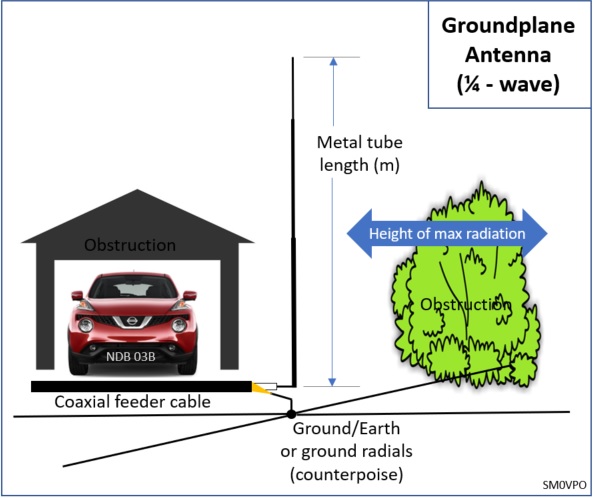
Trees and bushes are not nearly as bad a nearby buildings.
Horisontal:
The horisontal dipole (1/2-wavelength) antenna is physically mounted on a pole or mast. This means that the maximum radiation field is about 7 metres (in my case) above ground. The benefit is that I can see about 10dB more signal in tests in my back garden using a horisontal dipole. If there are no obstructions then the difference between vertical and horisontal is almost nothing. The width needed for any frequency is given by the formula:
Length is 142.5 / Frequency(MHz)
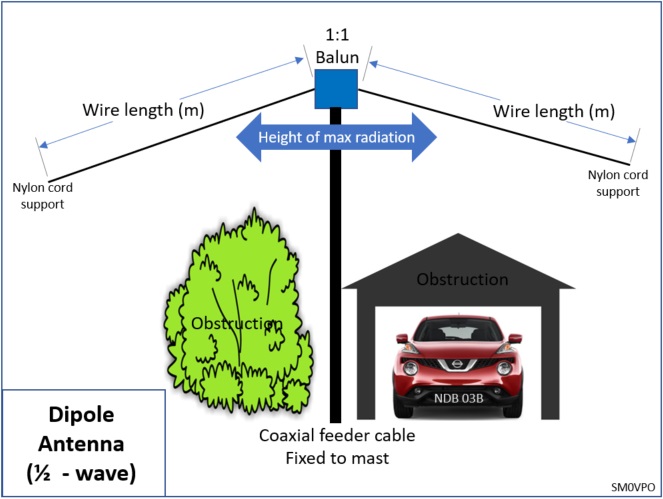
Trees have lesser absorption on horisontally polarised antennas.

When I operate a portable station from Rosersberg (outside my place of work) I use an MFJ-1979 16.5 foot (5.03m) stainless telescopic antenna. I have also added a coil of 4mm diameter aluminium wire.
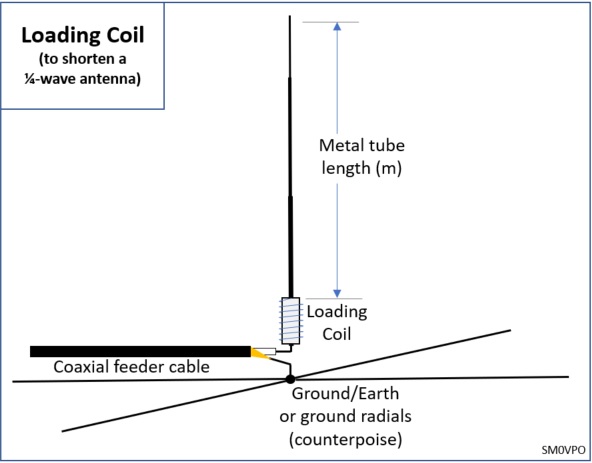
The coil is 53 turns, 10cm diameter (wound around a tin of pineapple) and with 1cm turn-spacing. I also used 10mm diameter plastic tube to support the coil, with 5mm holes drilled at 1cm intervals. 3D printed top and bottom spacers secure the coil around the antenna.
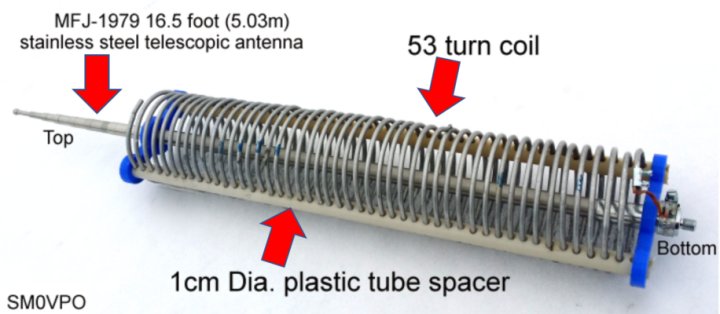
I connect the feeder shield to the ground radials, and the centre-conductor to a tapping of the coil with an alligator clip. With this arrangement and I can get about 1.1:1 on 3.5MHz through to 10.1MHz, with the full 5.03m telescopic antenna.
Be aware that the screw bolt-head at the bottom for mounting is NOT metric. If you have a wooden packing create then you can make holes in the top and bottom to support the antenna. I use this as a vertical groundplane antenna with three 5.4m radials. The telescopic antenna can be physically extended or retracted to get resonance at any frequency between 14.000 MHz and 29.700MHz. VSWR = 1:1 on all bands.
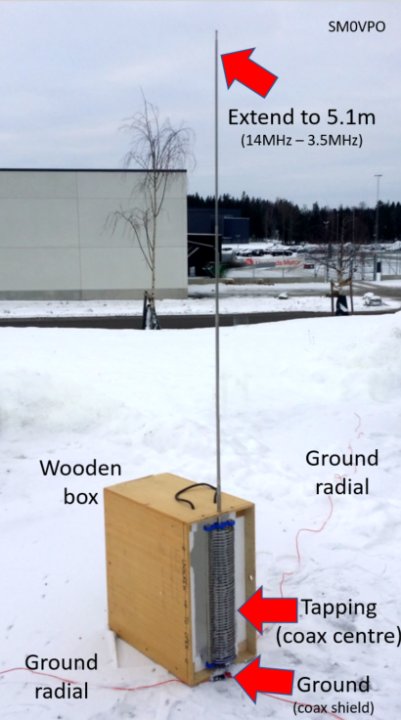
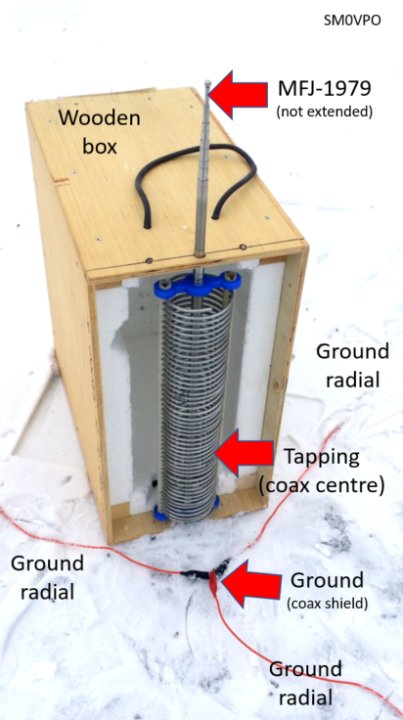
So my portable antenna needs no guy ropes and covers 3.5MHz to 29.7MHz without any Antenna Tuning Unit at all. No balun, unbalanced feeder. With only 50 Watts I can still put out a very respectable signal, and the whole lot (antenna, radio, car battery and cables) fit in the trunk of my little car where the spare tyre used to be stored.
The bad news is that measurements show something like a 10dB loss of received signal when I use this antenna in my garden at home. I even tried to use thicker aluminium tubes, but the results were exactly the same. I really need to go horisontal.

If you are fortunate enough to have some land without nearby obstructions, then the vertical ground-plane antenna can give good results. 5.2 metres is perfect for 14 MHz, but you can also use it for lower frequency bands by adding some inductance. You can use my "tapping" method for portable use, but for permanent installation you can fit a "Base-Loading Coil". If the antenna is too short then it will cave capacitive reactance. You can calculate and wind coils to do the job, which you can switch remotely, using a latching relay, energised with DC from your radio room. You can use the RF coaxial cable to pass the DC to the latching relays, using the polarity and diodes to select which relay you want to energise.
p>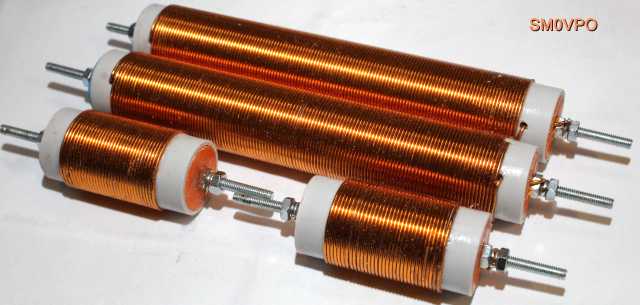
The formula was published in QST September 1974 for calculating the capacitive reactance, and the inductor value to cancel it. I have changed values to decimal and simplified the formula so only coils at the low-impedance feed point are considered (no offset). Here is a calculator for my modified formula:

Where:
LµH = inductance required for resonance
ln = natural log
f = frequency (megahertz)
A = overall antenna length (feet)
B = distance from center to each loading coil (inches)
D = diameter of radiator (inches)
If you want an accurate online form in feet and inches, then a good resouce is M0UKD's homepage.
(A negative value means the wire is longer than 1/4-wavelength)
Now all you need to do is take the number of microhenries and put the value in the coil winding formula to find out the number of turns. Just "guestimate" the coil length, say 100mm, and see how many turns you need. Multiply this by the diameter of the wire you are using (I used 0.8mm Diameter), and re-enter this in the formula. Repeat a couple of times until the result is the same as the last result.
| Formula: |  |
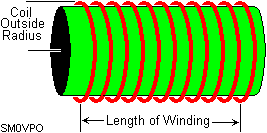 |
This coil solution works for a base-loaded groundplane antenna, but you will need two coils for the centre-fed dipole; one in each half, mounted at the feed-point.

The dipole is a 1/2-wavelength antenna, so a 7MHz antenna must be 142.5 / Frequency(MHZ) long, = 20.3 metres long, fed in the centre. That will not fit in my 8m wide garden. The 14.175MHz (centre of band) dipole will be 10.053 metres. I can slope the antenna to make an inverted-V, and also place it a little diagonally. That way the antenna only needs 9 metres of garden space.
Another interesting point is that the antenna has about 70 Ohms (ish) at resonance, although this can vary greatly with proximity of other antennas and even the ground. This is at the dipole centre feed-point. If not resonant then the impedance is much higher. So two (or more) antennas can be connected in parallel to form a dual, or multiband dipole. This what I did with all the horisontal experiments.

Base-loading a dipole requires two coils to be fitted, located at the feed-point. These are the same coils and calculations as used for the groundplane. It is not possible to use my tapped coil, unless you want to lower the antenna every time you want to make an adjustment, so you do need fixed coils. You can trim the antenna lengths to get the frequencies perfect.

Dipole antennas can be connected in parallel, so all I need to do is to calculate the required length of each dipole, then cut the wires to the correct length. With my 9 metres of space I can have a maximum of 10 metres, so I can have a full 1/2-wavelength for all bands from 14MHz through to 29.700MHz. No problem.
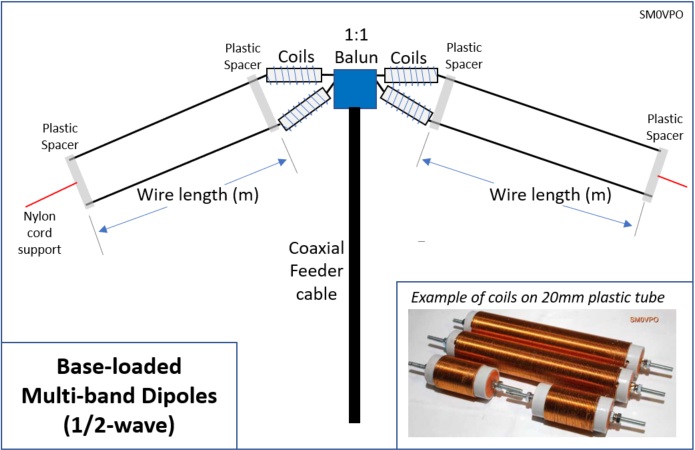
I use the formula 75/frequency(MHz) for each 1/4-wavelength section; that is to say without the 5% reduction due to "end effect". This means they will all be a tad too long, so I can always shorten them a little to tune them exactly. So here are my antenna length, with a few cm spare for trimming.
| 1/4-wave element | Length | Comment |
|---|---|---|
| 75m / 28.850MHz | = 2.599m | |
| 75m / 27.345MHz | = 2.743m | |
| 75m / 24.950MHz | = 3.006m | |
| 75m / 21.225MHz | = 3.534m | |
| 75m / 18.100MHz | = 4.144m | |
| 75m / 14.175MHz | = 5.291m | |
| 75m / 10.100MHz | = 7.389m | * |
| 75m / 7.100MHz | =10.563m | * |
| 75m / 3.700MHz | =20.270m | * |
| 75m / 3.600MHz | =20.283m | * |

This proved to be a bit of a problem. I found that when base-loading coils are used, the Q-factor increases, bandwidth is more narrow, and the efficiency falls because there is less "metal in the air". The greater is the coil to wire-length ratio, so the greater is the problem. Everything works ok. It looks a bit "Heath Robinson" and makeshift, but it is the technique and performance I was testing. Also, I am not at home in daylight so please excuse the night photographs.
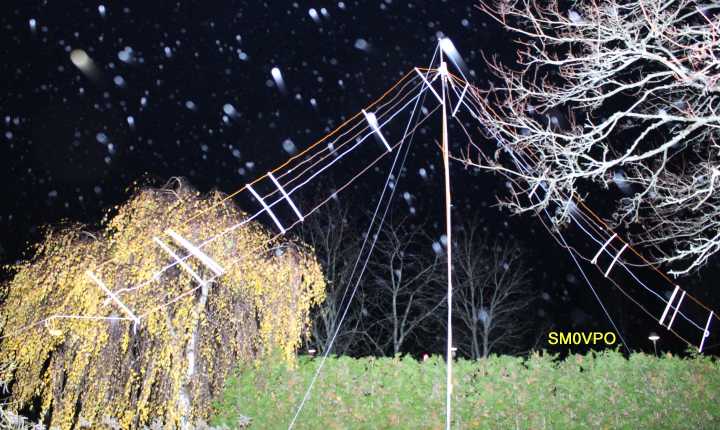
This first experiment works well and achieves all operational goals. It uses loaded dipoles for 3.7MHz and 7.1MHz, but straight (no-coils) for 14.17MHz, 27.3MHz and 29.0MHz. All five dipoles are connected to the same feed-point. A couple of extra loose spaces were added in case I wanted to add more dipoles for 18.1MHz and 21.2MHz.
Conclusion: coils do get you on the air and are simple to construct. I clearly needed to get a bit more metal-in-the-air and to eliminate the coils if I want to cover the full band and have a better efficiency below 14 MHz.
Another method is folding the dipoles. Experiment #3 (final version)

There are a lot of designs for Linear Loaded Dipoles, all you need do is google them. So I did a lot of reading and decided to give it a go. The results were quite surprising.
For 7.1MHz I needed each 1/4-wavelength section to be a "tad-longer" than 10 metres. So I used my 5m + 5m dipole, working on 14MHz upwards, and added more elements. Each 1/4-wave element must be a bit over 5m, so I made a zig-zag formation of 5 metres long, doubled back for 2.5 metres, then doubled back once more for the other 2.5 metres. This gives 10 metres of wire in each 1/4-wavelength element, but I could not find the resonance.
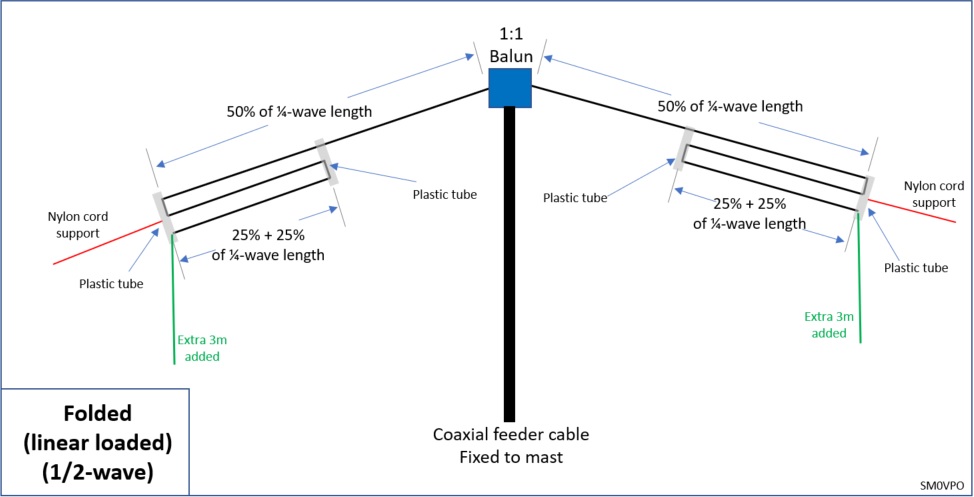
Wherever it was, it was nowhere near 7 MHz and I could not find it with my radio. So I used a signal generator, impedance bridge and a 100MHz oscilloscope. I found a beautiful dip in the impedance at about 9.4MHz. This means that the effective length was 7.5 metres. In other words, the 2.5 metre folded-back section cancels out 2.5 metres of the total length. Removing my socks and counting on my fingers and toes, I reckoned that I needed to add another 3 metres to each half. I didn't have enough space in the garden.
So I scratched my head a few times and realised that the centre of my dipole is 7.5 metres above the ground, but the ends are 3.5 metres above the ground. So I added 3 metres to each end and just let the wires hang vertically downwards. BINGO!! It now resonates at 7.120MHz and it still fits in my garden, but only just :-). Checking the bandwidth I find that it covers the whole 7MHz band with a VSWR of less than 1.4:1 from 7.0MHz to 7.2MHz. The Voice Of Russia is "romping in", large as life and twice as beautiful.
The only slight observation is that as the wind blows, the dangling 3 metre ends move around and the VSWR varies very slightly. A bit of nylon fishing-line tied to a rock stopped that :-).

Assembly is easy. All my dipole elements were deliberately cut too long. I don't want copper wires exposed, so joints are not acceptable. Instead of cutting, I rolled up the wire ends to shorten them. It was a little pain in the rectum to feed the 3mm wires through the holes, but the effect is that they are really secure and do not shift easily. I also secured the wires using 0.8mm magnet wire.

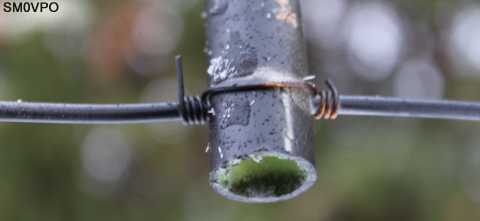
If I need to shorten a dipole element beyond the support/spacer tubes, then the surplus wire can also be doubled back and twisted around the element wire to cancel some of the unwanted length. For example, if you have 5.2 metres and you want 5.0 metres, then you only need to fold the last 100mm back up the dipole wire. It will be 5.1 metres, but electrically 5.0 metres.

I used plastic 30 cm electrical conduit tubes, 1 cm diameter for the spacers, except the end spacers. These are 2 cm diameter since they need to be stronger. I used cable that is 3 mm diameter, including the insulation, so all spacers are drilled with 3mm holes with 46.66 mm seperation, starting 10 mm from each end.

Water at the feed-point can have an impact on a multi-band dipole so I sprayed that part of the installation with a water-repellent spray intended for waterproofing clothes and shoes. This means it is a lot more stable in all weathers. Water also freezes in Swedish winters and you can get a lot of ice building up.
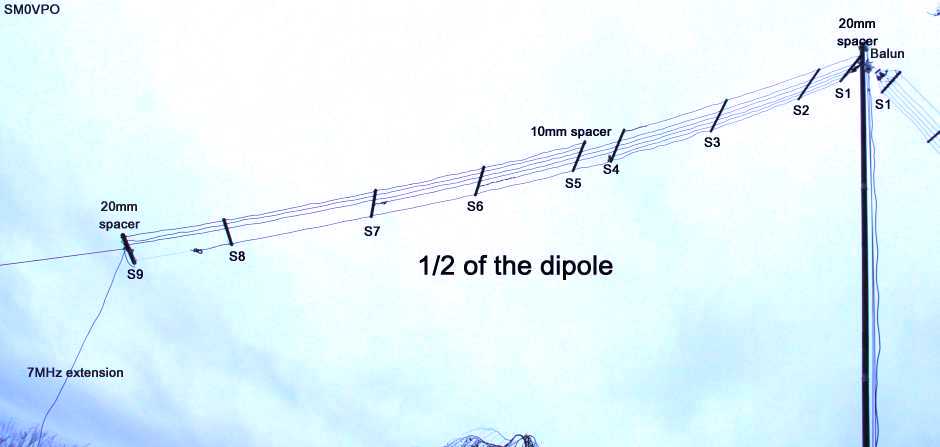

This was one of the major aspects for me. If it looks makeshift and is an eyesore, then it can attract unwanted attention from the community guys. Original experiments were done with a 5.5 metre mast (my original groundplane antenna) and it was so obvious with shiny metal that it stuck out like a sore thumb. Now I have used 38mm diameter steel TV-mast tubes and raised it to 7.5 metres. I painted the mast black and it is a lot less obvious from a distance: nothing to glint in the sun.
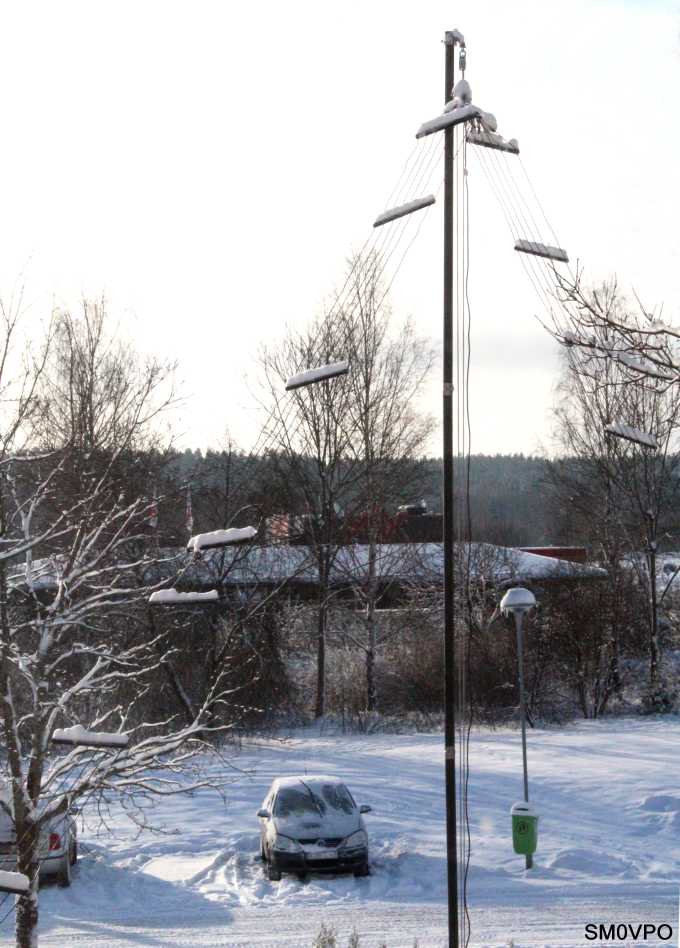
The original plastic spacers for the elements were all spaced 650mm wide, white plastic. The new ones are all 300mm long plastic tubes, painted black. 20mm diameter tubes for the end and centre spaces. All the middle tubes are only 10mm diameter. I also sprayed the wires black. The guy ropes I also boilled on the stove in black clothing dye. The dye did not take too well because the flagpole line is made of mylon, but they are dark enough to make them less visible. The mast guy-ropes are also fitted to the centre of the mast, NOT the top. In this way the mast pole is still ridgid and not visible over the surrounding bushes.
Another point is that the final version is so weighted that the 6 band elements are rotated horisontaly along the axis of the dipole, instead of vertically. When viewed from the side, all the elements are in the same plane so you can only see one element. You have to stand beneath the antenna array to see all six elements. With all of this the community guys will hopefully have very little to see.

This weekend I was on the radio and using all six bands. 10m and 11m are almost dead, but I had some good contacts on 21MHz, 18Mhz, 14MHz and 7MHz. I tested the 24.9MHz dipole but that band is very narrow, so I have removed it.
My antenna does not need any ATU (I don't believe in them), and the test broadcast stations show that the antenna is performing as well as I can get it, given the restricted space available.
It is difficult to see the antenna unless you are specifically looking for it. Not even guy-ropes are particularly visible. The guy ropes are secured to my 2 metre high fence on the one side, and the neighbours fence at the other side. The neighbour is a wonderful woman and we have helped her a lot with things, like repairing the kitchen lamp and taking garbage to the city dump. She was more than willing to allow me to tether my rope to her high fence. One of the guy ropes also supports the RG-58 feeder cable, so anyone wandering into our garden will not get strangled with hanging wires.
One last point is that I did some tests with the 1:1 feeder balun. At 50 Watts the VSWR was perfect, but when I increased the RF power to 150 Watts there was some movement on the VSWR meter. I replaced the balun for one that is ventillated, covers 1.8MHz to 30MHz, and can stand up to 1KW.

Yes, I do have plans for the future.
One of the ideas I was given from the forum was a mechanical arrangement to make the dipole lengths variable. I think that was a really smart idea, but with a little thought I can make a variable length dipole without any sliding contacts.
Another idea is to see if I can use some invisible "magnet wire" in the community tree that is beside my garden. I had to covertly trim parts of the tree to prevent branches from getting tangles in my dipole antenna. The tree also serves to hide my antenna a little, but my though now is that perhaps I can use it in some other way?
I also want to do something about all the QRM that is blanketing the 3.5 MHz band. Perhaps I can add another element to the dipole for good transmissions, but use a seperate antenna for receiving? Loops and frames are good, but for reception is is the signal to noise ratio that is important, not the signal level.

I have had a lot of fun experimenting and building this project. At long last I have managed to get a useable antenna system for the coming years. I hope that some of my thoughts and experiments can help you to become operational if you also have a small garden with a limited space. As I have learned, nothing is impossible if you can be a little inventive.
If you have any comments, suggestions or ideas for improvements then please do get in touch. I would prefer contact vi my forum as I try to avoid e-mail as much as possible. The SM0VPO forum is here.

Very best regards from Harry Lythall
SM0VPO, Märsta, Sweden (QRA = JO89WO))